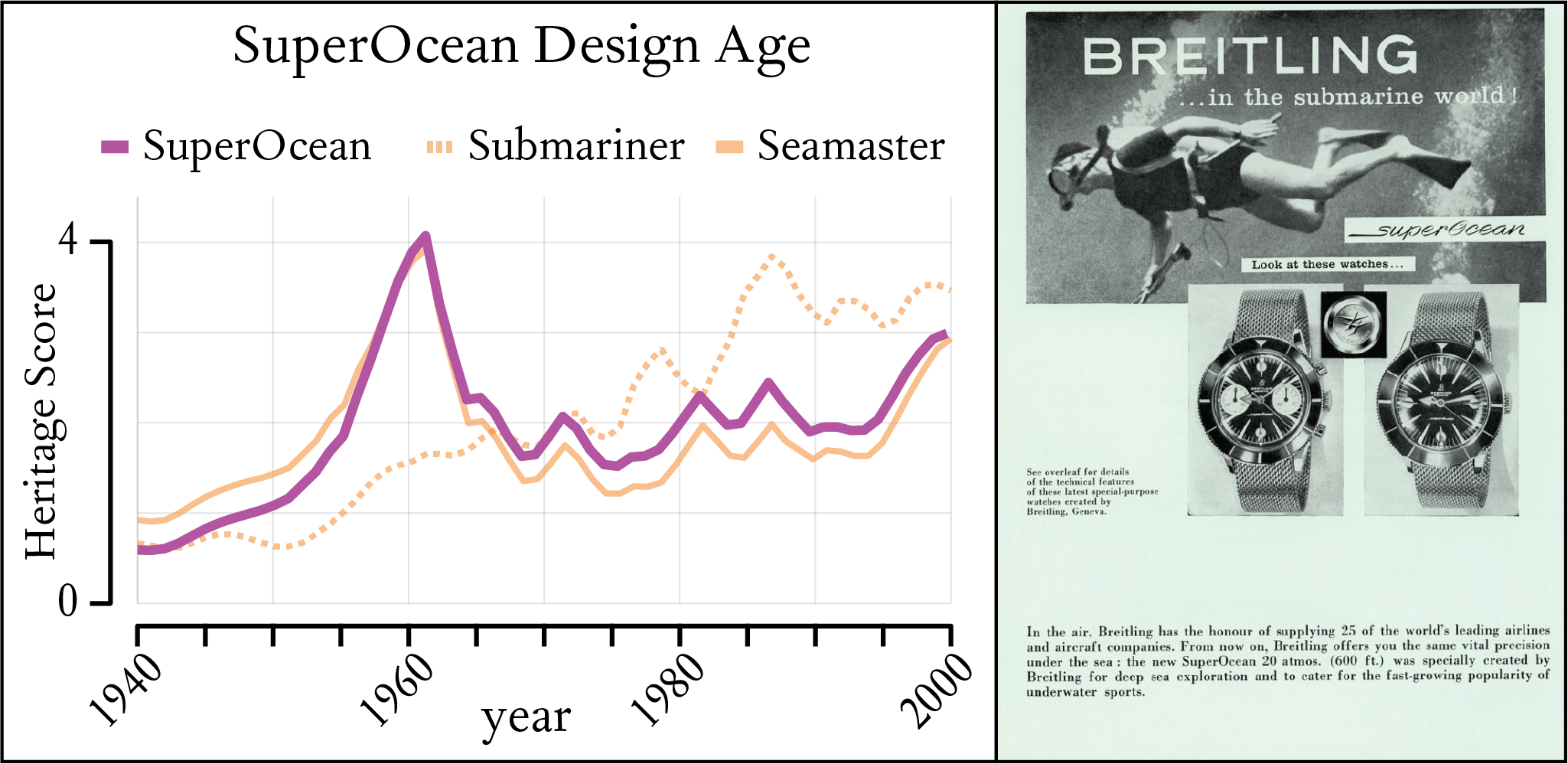Breitling is a brand most recognized for its chronograph watches. And not just any chronographs but pieces particularly aimed at aviation enthusiasts. However, it is also the brand to conquer air, land AND sea. So in 1957 Breitling set out to for the time dip their toe into the deep end of the pool... introducing the SuperOcean. A classic piece addressed to the recreational divers with clear legibility and the iconic bolt-like profile.
February 22, 2022
Breitling SuperOcean - It's Not Only About Chronographs
 Marcus Siems @siemswatches
Marcus Siems @siemswatches
Collector, Author, Data Analyst
Breitling is a brand most recognized for its chronograph watches. And not just any chronographs but pieces particularly aimed at aviation enthusiasts. However, in 1957 Breitling set out to not only conquer land and sky but for the time dip their toe into the deep end of the pool as well: In a time-only and chronograph version Breitling introduced the SuperOcean[1]. A classic piece addressed to the recreational divers with clear legibility and the iconic bolt-like profile.
 When you prepare for a Breitling story and it's not about chronographs... Photo @goldammer.me
When you prepare for a Breitling story and it's not about chronographs... Photo @goldammer.me
In the 1950s the demand for dive watches with serious water resistance increases appreciably. Scientific excursions start to map the oceans as also tourists start to map the beaches. The active lifestyle of the post-war era brings the amateur divers to the sea, all in need of reliable diving equipment. A new market evolved and one that would soon become a new archetype of modern watchmaking.
 Figure 7. The Design Age - weighted distribution of all key design elements - for the 1957 introduced Breitling SuperOcean (purple) in comparison to the 1954 Rolex Submariner 6204 (orange dashed) and the 1957 Omega Seamaster 300 CK2913 (solid orange)[2]. On the right is an ad for the Breitling SuperOcean, launched in 1957 (Courtesy Breitling SA).
Figure 7. The Design Age - weighted distribution of all key design elements - for the 1957 introduced Breitling SuperOcean (purple) in comparison to the 1954 Rolex Submariner 6204 (orange dashed) and the 1957 Omega Seamaster 300 CK2913 (solid orange)[2]. On the right is an ad for the Breitling SuperOcean, launched in 1957 (Courtesy Breitling SA).
From a design perspective, the SuperOcean hit the nerve of its time. Based on key elements this dive watch icon stands right next to the Omega Seamaster 300, ticking almost all the same boxes and as such opens us a window into the design language of the early 1950s/60s.
 For Breitling to be successful in the field of dive watches they had to compete with the best of their time - Rolex & Omega. Photo @goldammer.me
For Breitling to be successful in the field of dive watches they had to compete with the best of their time - Rolex & Omega. Photo @goldammer.me
However, from a technical standpoint upon introduction of the SuperOcean in 1957 the concept of a waterproof watch was nothing new. Most famously Rolex introduced the first waterproof case - the oyster case - in 1926[3-4] and the first rotational dive bezel in 1937 with the Zerograph[5-6].
Following put in 1932 Omega released its own “Marine”, the first watch specifically developed for diving, showcasing an unofficial depth rating of 135 meters[7-8]. Both brands were becoming the household names in this developing field - some 15 to 20 years before the introduction of their serially-produced Turn-O-Graph/Submariner[9-10] (1953/54) and Seamaster[11-12] (1948/57) divers.
 Breitling: When even your dive-watch advertorials speak about chronographs... Courtesy of Breitling SA
Breitling: When even your dive-watch advertorials speak about chronographs... Courtesy of Breitling SA
When Breitling entered the stage they were already a bit late to the divers party. So the first dive watch from this aeronautics powerhouse had to enter with a bang. Upon introduction in 1957 the SuperOcean 1004/807 could actually beat the two major players on the market - the Rolex Submariner & the Omega Seamaster - in water resistance with an astonishing 200m[13] (up until Omega matched that rating within the same year). Combined with a clean and clear design the SuperOcean made quite the entrance and established itself among the deep dive icons of its time.
 Figure 8. Distribution of Breitling vintage watches from 1940-2000 (734 total watches) grouped by design, highlighting the SuperOcean series (20 watches). The dots are color-coded by every watches’ age.
Figure 8. Distribution of Breitling vintage watches from 1940-2000 (734 total watches) grouped by design, highlighting the SuperOcean series (20 watches). The dots are color-coded by every watches’ age.
In our design cluster we see that the SuperOcean fills a unique part of history. This does not come too surprising, as Breitling did not often release pieces outside the realm of the ubiquitous chronograph archetype - less than 9% of Breitling watches are divers. However, what might not come as a given is that all the different iterations of this classic diver cluster so well.
After the initial classic Ref. 1004 SuperOcean Breitling quickly introduced the SuperOcean 2005 in 1964, a “slow motion” chronograph in which the central chrono hand needs exactly one hour to go around – as opposed to the typical 60 seconds. A strike of genius if you think of it, as 60 minutes is a way more relevant time-frame for a scuba-diver as are 60 seconds. Nevertheless, with bright luminous index hands, circular hour markers and a black-on-white dial quite the different approach to the original SuperOcean design language - as were the 1969 SuperOcean Chronomatic (Ref. 2105) and the 1983 Deep Sea (Ref. 81190)[1,13].
 1960s advertisement for the Breitling SuperOcean 2005 super-slow dive chronograph... Finally, we're back at chronographs. Courtesy of Breitling SA.
1960s advertisement for the Breitling SuperOcean 2005 super-slow dive chronograph... Finally, we're back at chronographs. Courtesy of Breitling SA.
That is the essence of the concept of design age: Even if watches look different their design can still very well represent the same time period. And this is exactly what we capture here. Two pieces might have different hand-sets, a different size, one might be a chronograph the other a classic diver but the combination of these assets might still be marked down within the same epoch.
And for the SuperOcean family their common denominator seems to be the association to nautical activities with a wink of leisurely dwelling in the beach sun. And right there lying on your towel, next to the soothing waves it's simply a stunning recreational dive-watch to do recreational things...
References
[1] Breitling in the Submarine World; Breitling;
https://www.breitling.com/us-en/heritage/superocean/
[2] Watches from Chrono24, extracted 2020 Nov. 29th & 2022 Jan. 06th; Karlsruhe, Germany;
[3] Rolex Oyster Case – Complete Guide & History; Millenary Watches;
https://millenarywatches.com/rolex-oyster-case/
[4] The Complete History of the Rolex Oyster Case; Paul Altieri, Bob’s Watches;
https://www.bobswatches.com/rolex-blog/history-of-time/complete-history-rolex-oyster-case.html
[5] The Mysterious Rolex Zerograph Chronograph; Ross Povery, Bulang & Sons;
https://magazine.bulangandsons.com/rolex-zerograph/
[6] The Most Important Rolex You’ve Never Heard of; Zen Love, Gearpatrol;
https://www.gearpatrol.com/watches/a34776246/watches-you-should-know-rolex-zerographe/
[7] Omega Marine: First Dive Watch; David Boettcher, VintageWatchStraps;
https://www.vintagewatchstraps.com/blogomegamarine.php
[8] A ‘Deep Dive’ Into The Omega Marine; Eric Mulder, Montres Publiques;
https://montrespubliques.com/new-1minute-reads/a-deep-dive-into-the-omega-marine
[9] The Revolutionary Turn-O-Graph; Phillips;
https://www.phillips.com/article/3831520/the-revolutionary-turn-o-graph
[10] History of the Rolex Submariner – Part 1, The Early References; Tom Mulraney, Monochrome Watches;
https://monochrome-watches.com/rolex-submariner-history-part-1-the-early-references/
[11] A Brief History of the Omega Seamaster; Anthony Tyme, Vintage Portfolio;
https://www.vintage-portfolio.com/de/a-brief-history-of-the-omega-seamaster/
[12] Omega Seamaster, eine Erfolgsgeschichte, die ihresgleichen sucht; Zeitenblick;
https://www.zeitenblick.at/omega-seamaster-history/
[13] The History and Evolution of the Breitling SuperOcean; Garrett Parker, MoneyInc;
https://moneyinc.com/the-history-and-evolution-of-the-breitling-superocean/
All rights on text and graphics reserved to the Author.




























Leave a comment